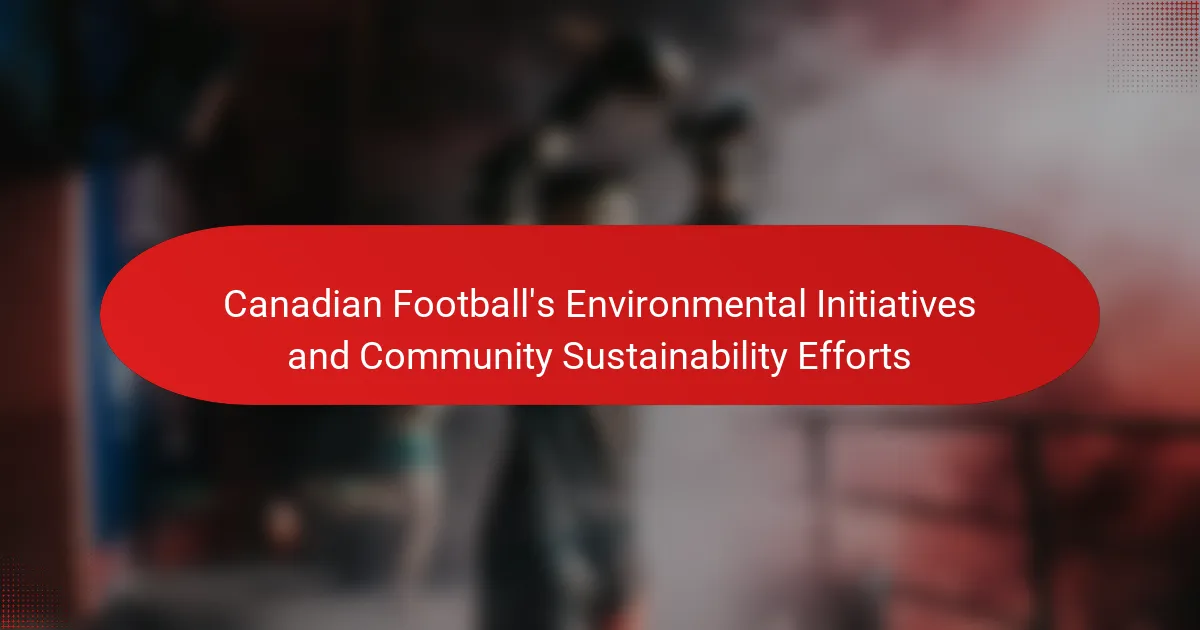Canadian football organizations are taking significant strides toward sustainability through various environmental initiatives. These include reducing carbon footprints, implementing recycling programs, and promoting green practices at stadiums. Community engagement is enhanced through clean-up events and educational programs aimed at youth. Additionally, teams face challenges such as funding limitations and regulatory compliance while striving for a more sustainable future.

What are the primary environmental initiatives in Canadian football?
Canadian football organizations actively engage in environmental initiatives to promote sustainability. These efforts include reducing carbon footprints, implementing recycling programs, and promoting green practices at stadiums. For example, the CFL has committed to sustainability by encouraging teams to adopt eco-friendly policies and practices. Community outreach programs further enhance awareness of environmental issues among fans and players alike.
How do teams implement sustainable practices?
Teams implement sustainable practices by integrating environmentally friendly initiatives into their operations. Canadian football teams focus on reducing waste, promoting recycling, and engaging in community sustainability projects.
For instance, many teams have adopted energy-efficient stadium designs, which minimize carbon footprints. They also participate in local environmental programs, such as tree planting and clean-up events, fostering community involvement. Additionally, educational campaigns raise awareness about sustainability among fans and players alike, encouraging eco-friendly behaviors.
These efforts not only benefit the environment but also enhance the teams’ reputations and strengthen community ties. By prioritizing sustainability, Canadian football teams demonstrate leadership in environmental stewardship.
Which organizations support these initiatives?
Several organizations support Canadian football’s environmental initiatives and community sustainability efforts. Key supporters include the Canadian Football League (CFL), which promotes eco-friendly practices across teams, and various local community groups focused on sustainability. Additionally, partnerships with environmental NGOs enhance these initiatives. Corporate sponsors also contribute by funding green projects and awareness campaigns. Collaborations with educational institutions help in research and development of sustainable practices within the sport.
What are the measurable outcomes of these efforts?
The measurable outcomes of Canadian football’s environmental initiatives and community sustainability efforts include reduced carbon emissions, increased recycling rates, and enhanced community engagement. For instance, teams have reported a 30% decrease in waste generation during events. Additionally, partnerships with local organizations have led to over 1,000 volunteer hours dedicated to sustainability projects. These efforts contribute to a greener environment and stronger community ties.

How does Canadian football engage with local communities for sustainability?
Canadian football actively engages with local communities through various environmental initiatives aimed at promoting sustainability. These efforts include community clean-up events, tree planting programs, and partnerships with local organizations focused on environmental education.
For instance, teams collaborate with schools to educate youth about recycling and conservation. Additionally, stadiums implement green practices, such as waste reduction and energy efficiency, which further involve fans in sustainability efforts.
As a result, Canadian football not only enhances community ties but also fosters a culture of environmental responsibility among its supporters. These initiatives exemplify how sports can play a vital role in promoting sustainable practices within local communities.
What community programs are associated with football teams?
Canadian football teams engage in various community programs focused on environmental initiatives and sustainability. These efforts aim to promote eco-friendly practices and enhance community well-being.
For example, teams often collaborate with local organizations to host tree planting events, recycling drives, and educational workshops on sustainability. The Toronto Argonauts have partnered with environmental groups to create awareness about climate change and its impact on local ecosystems.
Additionally, teams frequently implement green practices in their stadiums, such as energy-efficient lighting and waste reduction programs. The BC Lions have introduced initiatives to reduce their carbon footprint, including using renewable energy sources and promoting public transportation for fans.
These community programs not only foster a sense of responsibility but also strengthen the bond between the teams and their local communities.
How do these programs impact local environments?
Canadian football programs positively impact local environments through sustainability initiatives. These efforts include reducing carbon footprints, promoting recycling, and enhancing green spaces. For example, teams often engage in community clean-up events and tree planting campaigns. As a result, local ecosystems benefit from improved biodiversity and cleaner surroundings. Additionally, these initiatives foster community awareness and participation in environmental stewardship.
What role do fans play in community sustainability efforts?
Fans play a crucial role in Canadian football’s environmental initiatives and community sustainability efforts. Their engagement amplifies awareness and participation in eco-friendly practices.
Fan-driven campaigns contribute to waste reduction at games, encouraging recycling and composting. Community events often feature fans participating in tree planting and clean-up drives, fostering a sense of responsibility.
Moreover, fans influence team decisions on sustainability by advocating for greener stadium operations and renewable energy use. Their support can lead to partnerships with local organizations focused on environmental stewardship.
Through social media, fans spread information about sustainability initiatives, enhancing community involvement and education. This collective effort strengthens the bond between teams and their communities, promoting a sustainable future.

Which unique sustainability practices are adopted by specific Canadian football teams?
Several Canadian football teams implement unique sustainability practices. The BC Lions focus on reducing waste through recycling programs and community clean-up events. The Toronto Argonauts prioritize energy efficiency by using LED lighting in their stadium. The Calgary Stampeders engage in local partnerships to promote sustainable agriculture at their events. The Montreal Alouettes emphasize water conservation initiatives within their facilities. The Saskatchewan Roughriders support carbon offset programs through tree planting initiatives. These efforts reflect a commitment to environmental stewardship and community engagement across the league.
How does the Toronto Argonauts promote eco-friendly events?
The Toronto Argonauts promote eco-friendly events through initiatives that prioritize sustainability. They implement waste reduction strategies, utilize renewable energy sources, and engage in community outreach programs focused on environmental awareness. The team collaborates with local organizations to enhance recycling efforts during games and events. Additionally, the Argonauts encourage fans to adopt greener practices, contributing to a more sustainable game-day experience.
What innovative recycling programs has the BC Lions introduced?
The BC Lions have introduced several innovative recycling programs focusing on sustainability. These initiatives include a comprehensive waste management system that promotes recycling and composting at their games. The team collaborates with local organizations to enhance community engagement in environmental efforts. Additionally, they have implemented educational campaigns aimed at raising awareness about recycling practices among fans and the broader community. These programs reflect the BC Lions’ commitment to environmental responsibility and community sustainability.
How does the Calgary Stampeders integrate local resources?
The Calgary Stampeders actively integrate local resources to enhance sustainability and community engagement. They collaborate with local businesses for eco-friendly materials and services, promoting regional economic growth. Their initiatives include using renewable energy sources at their stadium and engaging in community programs that support environmental education. This approach not only reduces their carbon footprint but also strengthens ties with the local population, fostering a culture of sustainability.

What challenges do Canadian football teams face in implementing environmental initiatives?
Canadian football teams face significant challenges in implementing environmental initiatives, including funding limitations, community engagement, and regulatory compliance.
Funding for sustainability projects often competes with other operational costs. Many teams struggle to allocate resources for green initiatives, impacting their ability to invest in eco-friendly technologies.
Community engagement is crucial for successful environmental initiatives. Teams must educate fans and local communities about sustainability, which can be a challenge in areas with limited awareness or interest.
Regulatory compliance adds another layer of complexity. Teams must navigate various local and national regulations regarding waste management, energy use, and carbon emissions, which can be time-consuming and costly.
These challenges hinder the progress of Canadian football teams in their efforts toward environmental sustainability.
How do financial constraints affect sustainability efforts?
Financial constraints significantly hinder Canadian football’s sustainability initiatives. Limited budgets restrict investment in eco-friendly technologies and community programs. Teams often prioritize immediate financial stability over long-term environmental goals. As a result, many potential projects that promote sustainability remain unimplemented or underfunded.
What are the barriers to fan engagement in sustainability?
Barriers to fan engagement in sustainability include lack of awareness, limited accessibility, and insufficient incentives. Canadian football’s environmental initiatives face challenges in effectively communicating their sustainability efforts to fans. Many supporters may not understand the impact of these initiatives. Additionally, accessibility to sustainable practices at games can be limited, deterring participation. Lastly, without strong incentives, fans may not feel motivated to engage with sustainability efforts.
How do weather conditions impact sustainability practices?
Weather conditions significantly influence Canadian football’s sustainability practices. Extreme weather events can disrupt operations, prompting teams to adopt adaptive strategies. For instance, heavy rainfall may lead to field maintenance challenges, necessitating eco-friendly drainage solutions. Additionally, fluctuating temperatures impact energy consumption, driving initiatives toward renewable energy sources.
Teams are increasingly incorporating climate resilience into their community sustainability efforts. This includes promoting environmentally friendly transportation options for fans and enhancing recycling programs at stadiums. As a result, organizations are not only reducing their carbon footprint but also fostering a culture of sustainability among their supporters.
The unique attribute of Canadian football’s approach lies in its collaboration with local environmental groups. This partnership enables teams to implement localized sustainability projects, such as tree planting initiatives and community clean-up days. These efforts strengthen community ties while addressing environmental concerns.
In summary, weather conditions shape sustainability practices in Canadian football by necessitating adaptive strategies, promoting renewable energy, and fostering community engagement through unique partnerships.

What are the future trends in sustainability within Canadian football?
Canadian football is increasingly focused on sustainability through various environmental initiatives and community efforts. Teams are implementing green practices, such as reducing waste and promoting renewable energy use.
For example, the Canadian Football League (CFL) has partnered with local organizations to enhance community engagement in sustainability. Initiatives include tree planting events and educational programs about environmental stewardship.
Moreover, stadiums are adopting eco-friendly technologies, such as energy-efficient lighting and water conservation systems. These efforts not only reduce the carbon footprint but also foster a culture of sustainability among fans and players.
The future trends indicate a stronger commitment to sustainability, with potential advancements in carbon offset programs and increased collaboration with environmental groups. This approach enhances the sport’s image while contributing positively to the environment.
Which technologies are being explored for eco-friendly stadiums?
Several technologies are being explored for eco-friendly stadiums, focusing on sustainability. Solar panels harness renewable energy, while rainwater harvesting systems reduce water usage. Energy-efficient lighting and smart building materials enhance sustainability. Green roofs support biodiversity and improve insulation. Waste management systems promote recycling and composting.
How are policies evolving to support sustainability in sports?
Canadian football is evolving to enhance sustainability through various environmental initiatives and community efforts. The league has implemented measures like waste reduction programs, energy-efficient stadiums, and eco-friendly transportation options for fans.
Teams are actively engaging in community sustainability by promoting local food sourcing and supporting green projects. For example, the Toronto Argonauts partnered with local organizations to plant trees and enhance urban green spaces.
Additionally, the league is focusing on education and awareness programs that encourage fans to adopt sustainable practices. These initiatives aim to create a culture of environmental responsibility within the sports community.
As a result, Canadian football is not only contributing to environmental sustainability but also fostering community engagement and awareness around these crucial issues.
What role will youth engagement play in future initiatives?
Youth engagement will be crucial for Canadian football’s environmental initiatives and community sustainability efforts. Engaging young people fosters innovation and creativity, essential for addressing environmental challenges. Programs that involve youth in decision-making can enhance community ownership and accountability. For example, youth-led initiatives can drive awareness around sustainability practices in local football clubs. This involvement not only empowers youth but also ensures that future environmental strategies resonate with the values of the next generation.
What best practices can teams adopt for effective sustainability?
Teams can adopt several best practices for effective sustainability in Canadian football. First, they should implement energy-efficient technologies in stadiums to reduce carbon footprints. Second, promoting recycling and waste reduction initiatives during games fosters community involvement. Third, collaborating with local environmental organizations enhances outreach and education efforts. Lastly, setting measurable sustainability goals ensures accountability and progress tracking.
